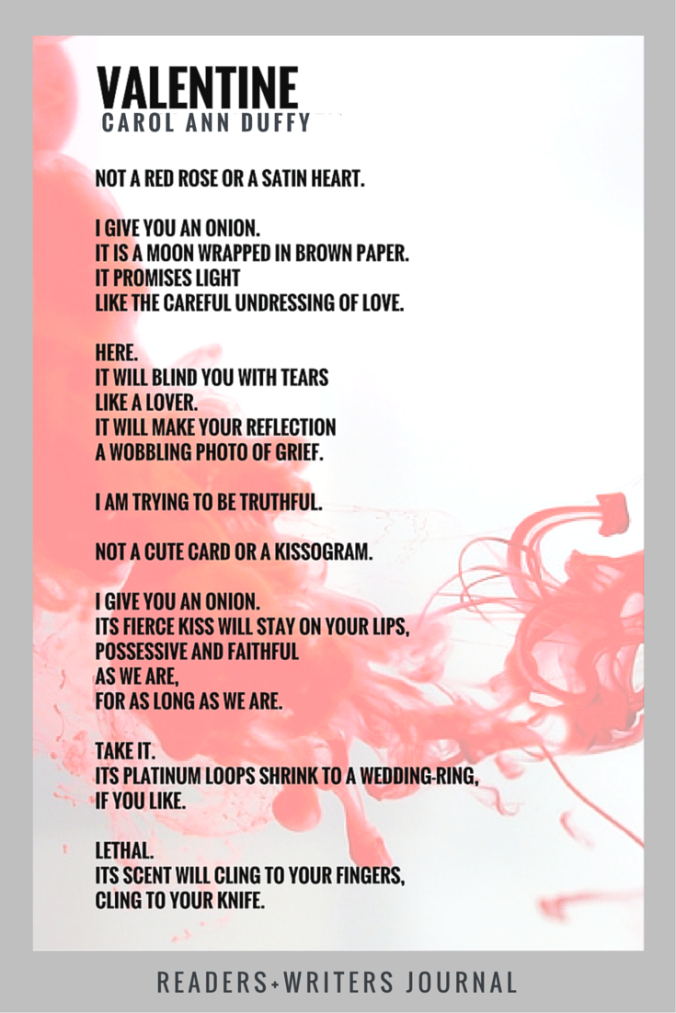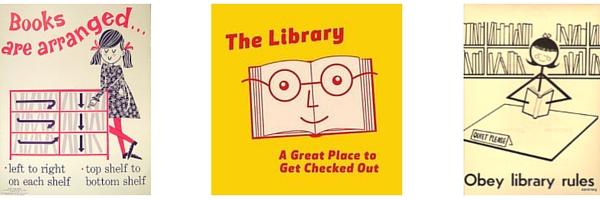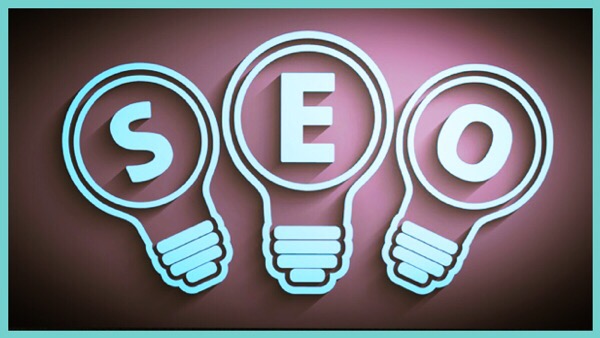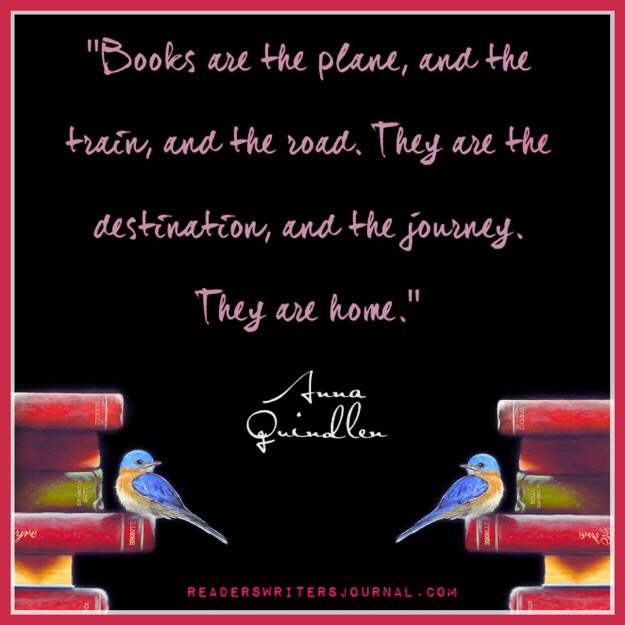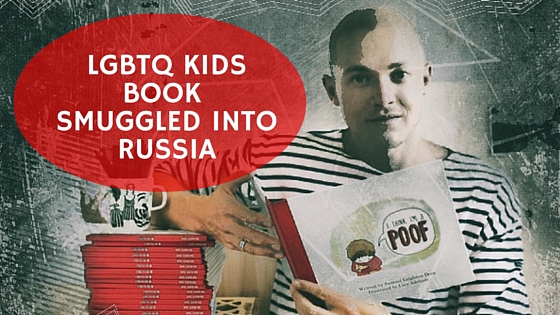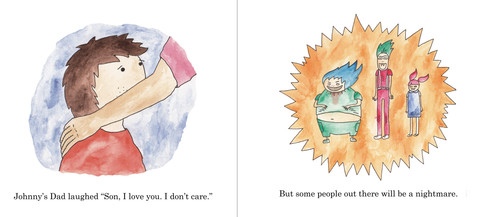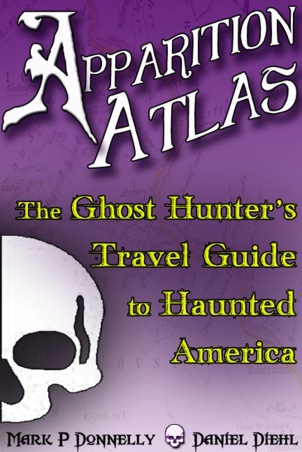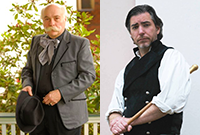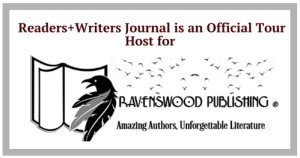Author Quotes – Honore de Balzac
“True love is eternal, infinite and always like itself. It’s always equal and pure. Without violent demonstrations: It is seen with white hairs and is always young at heart.”
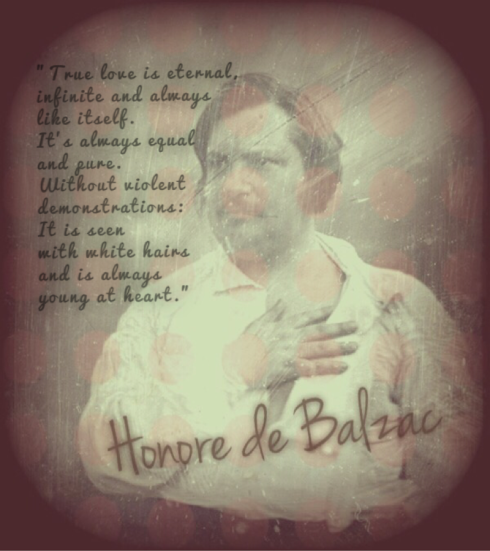
Honore de Balzac “True love is eternal, infinite and always like itself” quote
Honore de Balzac (20 May 1799 – 18 August 1850) was a French novelist and playwright. His magnum opus was a sequence of almost 100 novels and plays collectively entitled La Comedie Humaine, which presents a panorama of French life in the years after the fall of Napoleon Bonaparte in 1815.
Self Published Books and Libraries: How to Get Your Book onto Library Shelves
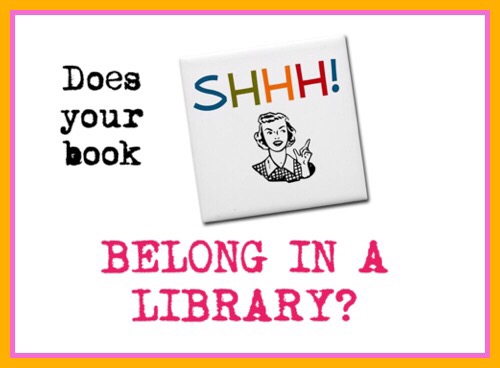 What Indie Authors Need to Know About the Library Market
What Indie Authors Need to Know About the Library Market
By Jane Friedman via Publishers Weekly
It has become a cliché to talk about how e-book distribution has leveled the playing field for indie authors and made the publishing environment more democratic. But accessing the library market remains somewhat more difficult for single authors with just a few titles.
While indie authors can gain some access to libraries by making their books available through major library distributors, that doesn’t mean that those books will be purchased. In many ways, getting self-published titles into libraries hasn’t changed since the e-book revolution: authors still have to prove that they have quality products that fit the collection. And, unfortunately, authors still face the stigma of self-publishing: there’s a long history of patrons offering to donate handwritten poetry collections or memoirs to their libraries.
Though some libraries work with their communities to publish local writing for their collections, that’s not what I want to address. Rather, I want to provide a framework for how self-published authors can understand the opportunities and challenges represented by the library market.
First, genre makes a difference. Those writing commercial fiction are better positioned. Self-publishing success stories are predominantly within genre fiction, and that’s where patron demand often lies, as well. Also, it’s easier for librarians to assess the quality of adult fiction than nonfiction. With nonfiction, librarians need reassurance that someone is vouching for the integrity of the information, as well as the author’s credentials. And children’s work has to reflect an understanding of children’s learning and development. (Some librarians I spoke with said that self-published genre fiction has achieved professionalism, whereas self-published children’s literature has not.)Second, discovery rarely happens through library databases. Librarians will not necessarily see or go looking for a self-published e-book just because it’s available through a service such as OverDrive—a major digital distributor to libraries. It becomes invisible in a sea of thousands of titles. Librarians have to know that the title exists, and that it is of quality, before they seek it out. Heather McCormack, who has been working for libraries since 1998, told me that at least a couple of times a month librarians ask her how to determine which self-published books to buy. Thus we come to the heart of the problem.
Traditionally, librarians find out about new books through trade publications such as Library Journal, PW, and School Library Journal. But most self-published titles are not reviewed by these journals, leaving librarians to come up with their own methods of discovery. McCormack says that there isn’t a trustworthy one-stop source for finding self-published titles, and librarians typically have more pressing concerns than staying on top of the indie market.
Uploading and Setting up your Amazon Ebook – Does SEO Really Matter?
Author Quotes – Anna Quindlen
Writer Anna Quindlen on the beauty, substance and significance of books
Anna Quindlen is the author of six previous bestselling novels (Rise and Shine, Blessings, Object Lessons, One True Thing, Black and Blue, and Every Last One), and eight nonfiction books (A Short Guide to a Happy Life, Good Dog. Stay., Being Perfect, Loud & Clear, Living Out Loud, Thinking Out Loud, How Reading Changed My Life, and Lots of Candles, Plenty of Cake). Her New York Times column “Public and Private” won the Pulitzer Prize in 1992. From 2000-2009, She wrote the “Last Word” column for Newsweek.
“BOOKS ARE THE PLANE, AND THE TRAIN, AND THE ROAD. THEY ARE THE DESTINATION, AND THE JOURNEY. THEY ARE HOME.” ― ANNA QUINDLEN, HOW READING CHANGED MY LIFE
Banned Books: A Chronological History
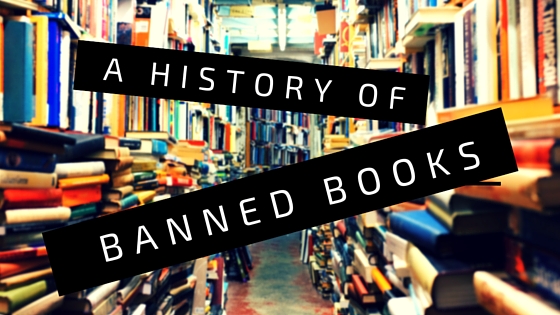 The Long History of Censorship, in 15 Books
The Long History of Censorship, in 15 Books
“When you tear out a man’s tongue, you are not proving him a liar, you’re only telling the world that you fear what he might say.” – George R.R. Martin
The saying goes that the pen is mightier than the sword. Apparently, authorities throughout history have agreed – the banning of words is older than printed books and in the United States, the first book banning occurred in 1637, 139 years before the country even existed.
From politically subversive texts to religious tracts that authorities felt threatened the majority rule to books deemed sexually inappropriate for young minds, the practice of banning speech, thoughts and words has always been a tool for political control. Those who defend the censorship of certain books may claim they are being protective, but the protection is usually of themselves.
The history of book banning and censorship is far from fully written: it continues throughout the world. Sometimes it takes the form of government bans, sometimes it comes from independent groups using threats or actual violence against writers. As you will see from the list below, the practice of trying to ban words is usually fruitless. Readers throughout history have found ways of reading what is forbidden, knowing that what is true cannot be held back and that the free exchange of ideas is a key to human progress.
Banned Books Throughout History
Below is a list, in order of when they were published, with an explanation of where and why they were banned.
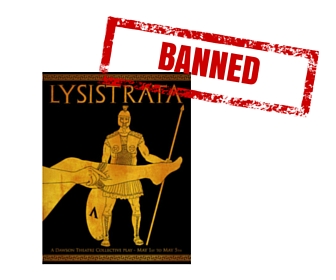 Lysistrata by Aristophanes – Written in 411 BCE
Lysistrata by Aristophanes – Written in 411 BCE
Aristophanes’ famous play about an Athenian woman’s mission to end the Peloponnesian War is one of Greek culture’s greatest gifts to the world. Ironically, the government of Greece banned the play in 1967, because of a perceived anti-war message.
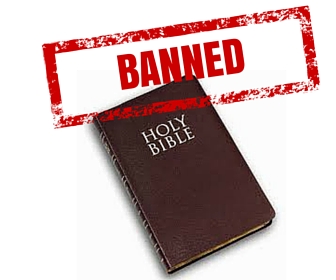 The Bible – First Printed in 1440
The Bible – First Printed in 1440
- Banned in the USSR from 1926 – 1956
- Banned in Ethiopa in 1986 (ban was later lifted)
- Owning or distributing the bible is currently restricted in multiple countries, including Afghanistan, Algeria, China, Comoros, Djibouti, Iran, Iraq, Libya, Maldives, Mauritania, Morocco, North Korea, Saudi Arabia, Somalia, Tunisia, Turkmenistan, Uzbekistan, and Yemen.
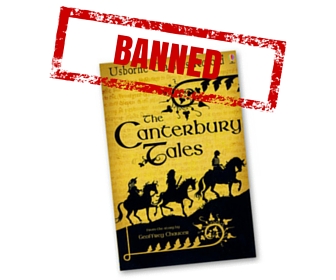 The Canterbury Tales by Geoffrey Chaucer – Published in 1440
The Canterbury Tales by Geoffrey Chaucer – Published in 1440
- Chaucer’s collection of stories was banned in the United States in 1873. While it was legal to posess a copy, it was illegal to MAIL it in the U.S., because it was found to violate the from the Federal Anti-Obscenity Act (Comstock Law), which banned the sending or receiving of books that contained “obscene,” “filthy,” or “inappropriate” material. The Comstock laws were effectively repealed by the United States Supreme Court in 1983.
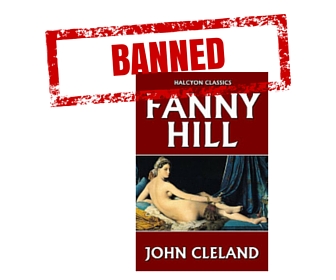 Fanny Hill or Memoirs of a Woman of Pleasure by John Cleland – Published in 1748
Fanny Hill or Memoirs of a Woman of Pleasure by John Cleland – Published in 1748
- Author John Cleland was in debtor’s prison when he wrote this book – hard up for money, he may have decided to write what sells: sex. Considered the first pornographic novel, Fanny Hill is one of the most banned books in history. It was first banned in the United States in 1821 for obscenity, and was re-banned in 1963. It is the last book ever officially banned in the U.S.
Frankenstein by Mary Shelley – Published in 1818
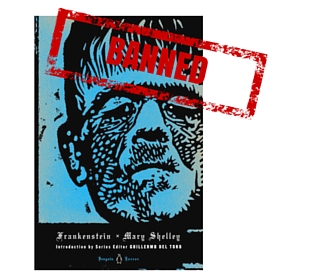 Mary Shelley’s classic about a scientist who plays God by creating a human-like creature was banned in Apartheid-era South Africa for containing “obscene and indecent” material.
Mary Shelley’s classic about a scientist who plays God by creating a human-like creature was banned in Apartheid-era South Africa for containing “obscene and indecent” material.
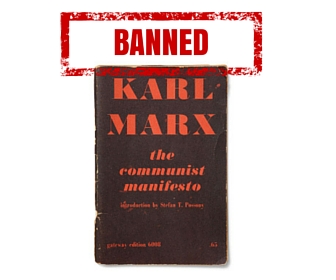 The Communist Manifesto by Karl Marx – Published in 1848
The Communist Manifesto by Karl Marx – Published in 1848
- Banned in Turkey from 1848 until 2013, for promoting Communism.
- In the mid-20th century, owning the Communist Manifesto or other communist literature was dangerous in many Western countries and could lead to loss of employment, investigation by government officials or even charges of treason.
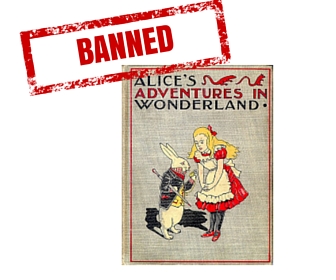 Alice’s Adventures in Wonderland by Lewis Carroll – Published in 1865
Alice’s Adventures in Wonderland by Lewis Carroll – Published in 1865
- The beloved children’s classic was banned in China in 1931, for portraying animals as having the same complexity as human beings. Chinese censors warned of the “disastrous” effects of teaching children to have the same respect for animals as humans.
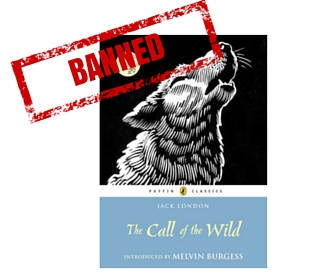 The Call of the Wild by Jack London – Published in 1902
The Call of the Wild by Jack London – Published in 1902
- The European dictatorships of the 1920’s and 1930’s, most notably in Yugoslavia and Italy, banned Jack London’s classic because of the author’s supposed sympathy for socialism. In 1933, Germany’s Nazi party banned (and held mass burnings of) the book for being “too radical”.
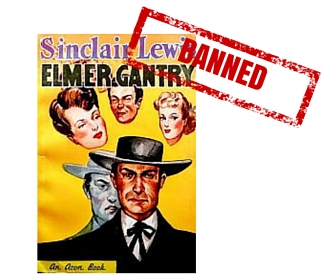 Elmer Gantry by Sinclair Lewis – Published in 1927
Elmer Gantry by Sinclair Lewis – Published in 1927
- Sinclair Lewis’ examination of religious hucksterism is widely considered one of the best American satirical novels of the 20th century. But when it was published, it was banned in cities throughout the United States. Perhaps the satiric portrayal of evangelical Christianity hit too close to home – it was denounced from church pulpits all over North America.
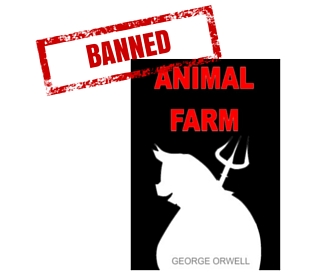 Animal Farm by George Orwell – Published in 1945
Animal Farm by George Orwell – Published in 1945
Orwell finished writing his most widely read novel in 1943, while the world was at war. He could not find a publisher in Great Britain willing to publish it, because of its criticism of Russia, an ally of Britain. Once published, it was immediately banned in most communist countries. It remains a banned book in the United Arab Emirates, because its talking pig character is deemed “un-Islamic.” It is also still banned in North Korea and censored in Vietnam, probably because of its perceived criticism of socialism.
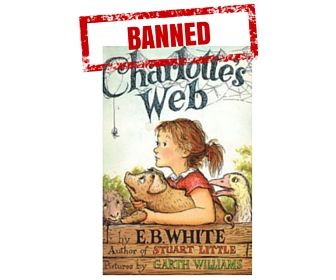 Charlotte’s Web by E.B. White – Published in 1952
Charlotte’s Web by E.B. White – Published in 1952
- White’s classic about the friendship between a pig named Wilbur and a spider named Charlotte has sold over 45 million copies and has been translated into 23 languages. It has also been repeatedly banned. A school in Yorkshire, England banned it in 2003, citing its potential to offend Muslim students. The ban was lifted after The Muslim Council of Britain formally requested an end to the “well-intentioned but misguided” policy.
- In the United States in 2006, a Kansas school district decided that talking animals were “unnatural” and “blasphemous” and briefly banned Charlotte’s Web.
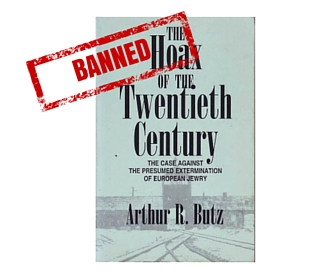 The Hoax of the Twentieth Century: The Case Against the Presumed Extermination of European Jewry by Arthur Butz – Published in 1977
The Hoax of the Twentieth Century: The Case Against the Presumed Extermination of European Jewry by Arthur Butz – Published in 1977
Electrical engineer Arthur Butz’s extremely controversial book, which attempts to refute the idea that millions of Jews were exterminated during the Second World War is banned in Canada as hate literature. The Royal Canadian Mounted Police destroyed copies of the book as recently as 1995.
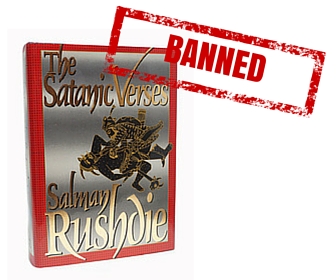 The Satanic Verses by Salman Rushdie – Published in 1988
The Satanic Verses by Salman Rushdie – Published in 1988
The publication of The Satanic Verses caused a firestorm of protest in parts of the Islamic world when it was first published. Author Salman Rushdie received numerous death threats, including one issued by Ayatollah Ruhollah Khomeini of Iran, ordering Muslims to kill Rushdie. The book has been banned on the grounds that it blasphemes Islam for over 20 years in 15 countries: Bangladesh, Egypt, India, Iran, Kenya, Kuwait, Liberia, Malaysia, Papua New Guinea, Pakistan, Senegal, Singapore, Sri Lanka, Tanzania and Thailand.
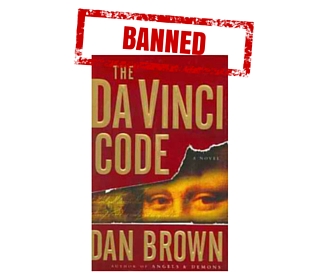 The Da Vinci Code by Dan Brown – Published in 2003
The Da Vinci Code by Dan Brown – Published in 2003
Dan Brown’s 2003 mystery about secret societies, art and the Catholic church was a sensation when it was first published in 2003. In 2004, Catholic leaders in Lebanon deemed it “offensive to Christianity” and banned it.
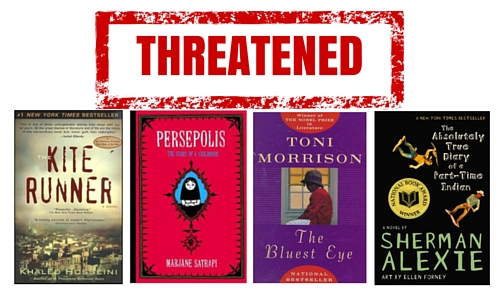 Ongoing Threats to Books – 2015
Ongoing Threats to Books – 2015
As we reported in 2014, the effort to ban books in the United States continues in school systems and libraries around the country. For more information about books that are partially banned or under threat of ban and information about how you can stand up for threatened books, please visit the American Library Association’s Banned Books Website.
Book for Gay Children Becomes Symbol of Defiance in Moscow
Russia’s Beleaguered LGBT Community Embraces Australian Children’s Book
By ERYK BAGSHAW via The Sydney Morning Herald
Samuel Leighton-Dore was five years old when he realised he was gay.
“When I was playing Lion King with the boys up the street I always wanted to be the cub that got licked by the dad,” he said.
“I was always interested in boys, but there was no presence of gay protagonists or characters in what I was reading or the films I was watching so I didn’t really have a word for it.”
Over the next decade Leighton-Dore would go through the confronting and often brutal experience of school in Sydney.
In and out of counselling, “I felt isolated by my sexuality long, long, before I’d ever been sexually active”, he said.
“I couldn’t walk across the playground in Homebush without being called a ‘gaylord’ or ‘faggot’.
Samuel Leighton-Dore was five years old when he realised he was gay.
“When I was playing Lion King with the boys up the street I always wanted to be the cub that got licked by the dad,” he said.
“I was always interested in boys, but there was no presence of gay protagonists or characters in what I was reading or the films I was watching so I didn’t really have a word for it.”
Over the next decade Leighton-Dore would go through the confronting and often brutal experience of school in Sydney.
In and out of counselling, “I felt isolated by my sexuality long, long, before I’d ever been sexually active”, he said.
“I couldn’t walk across the playground in Homebush without being called a ‘gaylord’ or ‘faggot’.“I wish I could go back and tell my seven-year-old self that these 10 years are going to be hard, but there is light at the end of the tunnel.”
Now the 23-year-old has done just that, self-publishing a children’s book titled “I Think I’m a Poof.”
Leighton-Dore and illustrator Lucy Adelaide take readers on the journey of Johnny – a child struggling with his sexual identity.
“Johnny woke his dad in the middle of the night,” the book’s opening lines read. “He had tears in his eyes, something wasn’t right. Johnny’s dad sat up and whispered, is something aloof? Johnny looked to ground and replied, I think I’m a poof.”
Meetings with publishing powerhouse Hardie Grant were productive, but ultimately landed the 27-page picture book in the “too risky” basket.
The publisher declined to comment on why it didn’t proceed to press.
Leighton-Dore’s friend Henry Gelbart ultimately stumped up the cash to get it to print, but that was only half the battle.
Nervous bookshops would not stock the small initial run of 2000 books, said Leighton-Dore.
Among them, Better Read Than Dead, a book store in perhaps Sydney’s most progressive enclave, Newtown.
“There is no way that I would give that book to a child,” said the store’s manager, Amelia Lush. “It plays with stereotypes of sexuality which I wasn’t really comfortable with, particularly as a queer person.
“At the moment gay kids are being bullied across the country. I’m not going to stock any material that is likely to increase that through using words like poof, queen and fairies.”
Despite the relatively small circulation, copies of the book have been smuggled into Moscow, where LGBT (lesbian, gay, bisexual, and transexual) groups are forced underground to discuss politics under the guise of learning English.
In the cobbled streets by the Kremlin, Leighton Dore’s book has become a small symbol of defiance.
“What we’re doing is completely illegal,” one of the Moscow group’s leaders, Tatiana, tells Leighton Dore in an email. “We are constantly terrified that the police will come for us – that they’ll beat and arrest us.”
Leighton-Dore said he wanted to empower the gay community through taking back ownership of terms like “poof”. He hopes that one person in particular sees it that way too – the British actor, presenter and activist Stephen Fry.
“Getting Stephen Fry to read the book out loud has always been the dream,” he said.
Buy a copy of “I Think I’m a Poof”
Samuel Leighton-Dore on Twitter
Stephen Fry on Twitter (In case you’d like to urge him to read the book)
Pixar’s Rules of Storytelling
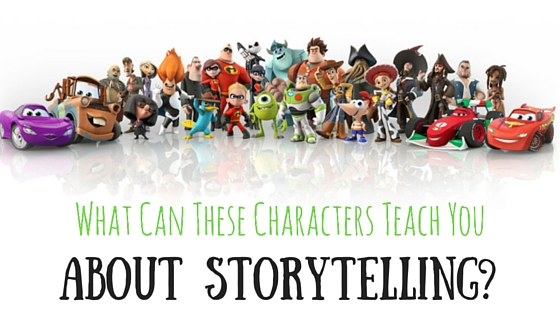 22 Secrets of a Great Story Line from Animation’s Greatest Storyteller
22 Secrets of a Great Story Line from Animation’s Greatest Storyteller
Pixar Animation Studios, the American computer animation film studioknown for its CGI-animated feature films, knows a thing or two about how to tell a compelling story. From it’s first film, 1995’s “Toy Story” to “Monsters, Inc.” to “Finding Nemo” and it’s most recent release, “Inside Out,” the animation giant continues to create blockbusters that thrill both children and adults.
How do you create a story line that becomes an instant classic? A Pixar story artist, Emma Coats, recently tweeted a series of “story basics” learned from her work with Pixar. Below are the 22 guidelines for story and plot – Pixar’s guide to storytelling.
#1: You admire a character for trying more than for their successes.
#2: You gotta keep in mind what’s interesting to you as an audience, not what’s fun to do as a writer. They can be v. different.
#3: Trying for theme is important, but you won’t see what the story is actually about til you’re at the end of it. Now rewrite.
#4: Once upon a time there was ___. Every day, ___. One day ___. Because of that, ___. Because of that, ___. Until finally ___.
#5: Simplify. Focus. Combine characters. Hop over detours. You’ll feel like you’re losing valuable stuff but it sets you free.
#6: What is your character good at, comfortable with? Throw the polar opposite at them. Challenge them. How do they deal?
#7: Come up with your ending before you figure out your middle. Seriously. Endings are hard, get yours working up front.
#8: Finish your story, let go even if it’s not perfect. In an ideal world you have both, but move on. Do better next time.
#9: When you’re stuck, make a list of what WOULDN’T happen next. Lots of times the material to get you unstuck will show up.
#10: Pull apart the stories you like. What you like in them is a part of you; you’ve got to recognize it before you can use it.
#11: Putting it on paper lets you start fixing it. If it stays in your head, a perfect idea, you’ll never share it with anyone.
#12: Discount the 1st thing that comes to mind. And the 2nd, 3rd, 4th, 5th – get the obvious out of the way. Surprise yourself.
#13: Give your characters opinions. Passive/malleable might seem likable to you as you write, but it’s poison to the audience.
#14: Why must you tell THIS story? What’s the belief burning within you that your story feeds off of? That’s the heart of it.
#15: If you were your character, in this situation, how would you feel? Honesty lends credibility to unbelievable situations.
#16: What are the stakes? Give us reason to root for the character. What happens if they don’t succeed? Stack the odds against.
#17: No work is ever wasted. If it’s not working, let go and move on – it’ll come back around to be useful later.
#18: You have to know yourself: the difference between doing your best & fussing. Story is testing, not refining.
#19: Coincidences to get characters into trouble are great; coincidences to get them out of it are cheating.
#20: Exercise: take the building blocks of a movie you dislike. How d’you rearrange them into what you DO like?
#21: You gotta identify with your situation/characters, can’t just write ‘cool’. What would make YOU act that way?
#22: What’s the essence of your story? Most economical telling of it? If you know that, you can build out from there.
10 of the Best Podcasts for Writers and Readers
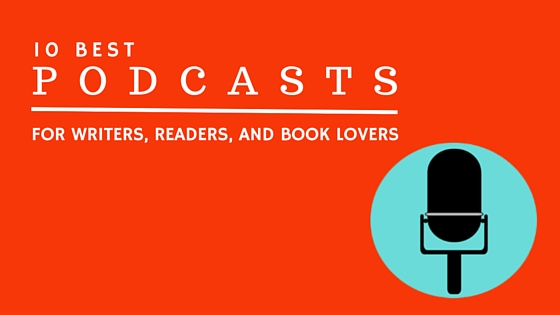 Learn About Writing, Self-Publishing, New Books and More – Free
Learn About Writing, Self-Publishing, New Books and More – Free
Podcasts are a great (and free!) way to learn new skills, catch up on trends in publishing, learn more about your favorite authors and hear the perspectives of readers. But where do you find the best podcasts for writers? The best podcasts for book lovers? The best podcasts for self-publishing? The term “podcast” has been in use for only 10 years, but it seems like there are literally millions of them to choose from. With limited time (and patience) how do you find the most valuable, useful and interesting book-related podcasts? We’ve done it for you! Below are some of the best of the best podcasts for writers, readers and for anyone interested in books. Enjoy!
The Best Podcasts on Writing
The Writing University Podcasts
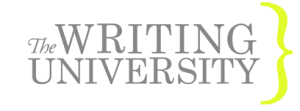 Run by the Iowa Writers’ Workshop, arguably the most influential and prestigious writing program in the United States (alumni include Flannery O’Connor, John Irving, and Ann Patchett) these podcasts usually feature a guest writer talking about the art of writing. Some find the Writing University podcasts a bit too academic, but there is enough here for everyone, on topics ranging from the intricacies of character to how we use our brain when we write to how to work with a writing deadline. Visit Website
Run by the Iowa Writers’ Workshop, arguably the most influential and prestigious writing program in the United States (alumni include Flannery O’Connor, John Irving, and Ann Patchett) these podcasts usually feature a guest writer talking about the art of writing. Some find the Writing University podcasts a bit too academic, but there is enough here for everyone, on topics ranging from the intricacies of character to how we use our brain when we write to how to work with a writing deadline. Visit Website
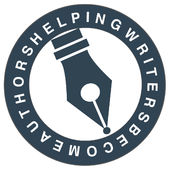 Helping Writers Become Authors
Helping Writers Become Authors
Created by author K.M. Weiland, this site offers specific, hard-core writing advice on everything from how to structure a story to ways to invigorate sentence structure to crafting unforgettable characters. Voted one of the top 101 websites for writers, by Writer’s Digest, if you’re an author or aspiring writer, you will find something of value in these podcasts. Visit Website
The Dead Robots Society
 Worth it for the title alone, but there is much more here than a catchy name. Described as a series “by aspiring writers for aspiring writers,” most episodes are hosted by 3 writers, all with their own points of view and experiences. Episodes often feature guests discussing topics like how to begin a fiction story, book cover blurbs, and sequels. This site tends to have long (over an hour) podcasts, but they’re formatted as conversations, so they rarely get boring. Visit Website
Worth it for the title alone, but there is much more here than a catchy name. Described as a series “by aspiring writers for aspiring writers,” most episodes are hosted by 3 writers, all with their own points of view and experiences. Episodes often feature guests discussing topics like how to begin a fiction story, book cover blurbs, and sequels. This site tends to have long (over an hour) podcasts, but they’re formatted as conversations, so they rarely get boring. Visit Website
Writing Excuses
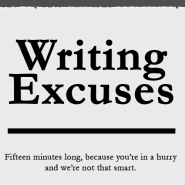 These are short (15 minutes per episode), lively weekly podcasts hosted by Brandon Sanderson, Dan Wells, Mary Robinette Kowal and Howard Tayler, covering mostly fiction writing topics. Recent podcast subjects include plot twists, pacing, and how to control a reader’s sense of progress. Visit Website
These are short (15 minutes per episode), lively weekly podcasts hosted by Brandon Sanderson, Dan Wells, Mary Robinette Kowal and Howard Tayler, covering mostly fiction writing topics. Recent podcast subjects include plot twists, pacing, and how to control a reader’s sense of progress. Visit Website
The Best Podcasts on Self-Publishing and Book Marketing
(Note: many self-publishing/book marketing podcasts will try to sell you something – usually a self-publishing “secret” or system. Some are good products, others less so. We’ve tried to include only the less sales-oriented sites here.)
The Creative Penn Podcast
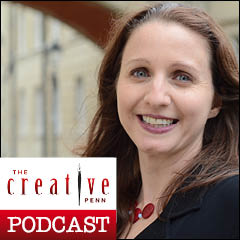 Author and self-publishing pioneer Joanna Penn’s website, courses, and books are truly gems for writers – they cover everything from how to write to how to market your book. And her podcasts live up to the same standard as the rest of Penn’s products: informative, well-researched and based on her own experiences. There are interviews with authors, marketers, case studies on what works and what doesn’t in book marketing, and writing tips galore. You can watch free on Youtube or if you learn best by reading, Penn provides links to transcripts for all of her podcasts. Visit Website
Author and self-publishing pioneer Joanna Penn’s website, courses, and books are truly gems for writers – they cover everything from how to write to how to market your book. And her podcasts live up to the same standard as the rest of Penn’s products: informative, well-researched and based on her own experiences. There are interviews with authors, marketers, case studies on what works and what doesn’t in book marketing, and writing tips galore. You can watch free on Youtube or if you learn best by reading, Penn provides links to transcripts for all of her podcasts. Visit Website
Sterling & Stone Self-Publishing Podcast
 They bill themselves as “3 guys telling you what does and doesn’t work for them in indie publishing.” The three guys are sci-fi authors Sean Platt, David Wright and Johnny B. Truant, and they cover topics ranging from how to optimize an Amazon sales page to how to price your books to how to get through writer’s block. The podcasts often feature guests from the world of publishing and marketing. Visit Website
They bill themselves as “3 guys telling you what does and doesn’t work for them in indie publishing.” The three guys are sci-fi authors Sean Platt, David Wright and Johnny B. Truant, and they cover topics ranging from how to optimize an Amazon sales page to how to price your books to how to get through writer’s block. The podcasts often feature guests from the world of publishing and marketing. Visit Website
The Sell More Books Show
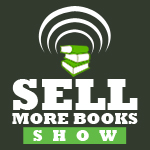 Hosted by internet marketing guru Jim Kukral, this podcast covers publishing industry news, new developments in the world of self-publishing, and the nitty-gritty of selling a book. The hosts are extremely knowledgeable and always produce high-quality podcasts. There are some sales pitches included on the site, but the podcasts are well worth weeding through the “download this guide to selling books” links. Visit Website
Hosted by internet marketing guru Jim Kukral, this podcast covers publishing industry news, new developments in the world of self-publishing, and the nitty-gritty of selling a book. The hosts are extremely knowledgeable and always produce high-quality podcasts. There are some sales pitches included on the site, but the podcasts are well worth weeding through the “download this guide to selling books” links. Visit Website
The Best Podcasts on Literature, Books and Reading
A Phone Call from Paul
 Literary Hub’s new podcast series features writer/interviewer and member of the literary intelligentsia Paul Holdengraber talking about books and writing with his friends on the phone. The first podcast featured Paul talking to his friend Neil Gaiman, about life, death, books, fatherhood, and everything in between. It’s just beginning, but this promises to be an exciting series, complete with snazzy 1970’s theme song. Visit Website
Literary Hub’s new podcast series features writer/interviewer and member of the literary intelligentsia Paul Holdengraber talking about books and writing with his friends on the phone. The first podcast featured Paul talking to his friend Neil Gaiman, about life, death, books, fatherhood, and everything in between. It’s just beginning, but this promises to be an exciting series, complete with snazzy 1970’s theme song. Visit Website
Book Riot Podcast
![]() Hosted by Book Riot editors Jeff O’Neal and Rebecca Schinsky, this literary podcast bills itself as “A weekly news and talk show about what’s new, cool, and worth talking about in the world of books and reading.” The format is conversational and often humorous, and the topics are wide-ranging: from new authors to the psychology of reading and writing to new technologies to publishing news and events. Visit Website
Hosted by Book Riot editors Jeff O’Neal and Rebecca Schinsky, this literary podcast bills itself as “A weekly news and talk show about what’s new, cool, and worth talking about in the world of books and reading.” The format is conversational and often humorous, and the topics are wide-ranging: from new authors to the psychology of reading and writing to new technologies to publishing news and events. Visit Website
Books on the Nightstand
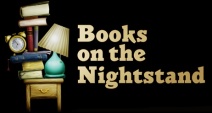 Publishing industry veterans Michael Kindness and Ann Kingman offer insight into reading, book recommendations, highlight classic books worth re-reading and profile new books you should check out. They feature audio books more extensively than many other book podcasts, and their “books we can’t wait to read” podcasts cover every genre – from thrillers to literary fiction to coloring books. Visit Website
Publishing industry veterans Michael Kindness and Ann Kingman offer insight into reading, book recommendations, highlight classic books worth re-reading and profile new books you should check out. They feature audio books more extensively than many other book podcasts, and their “books we can’t wait to read” podcasts cover every genre – from thrillers to literary fiction to coloring books. Visit Website
Last Chance to Enter to Win a Free Paranormal Guide Book!
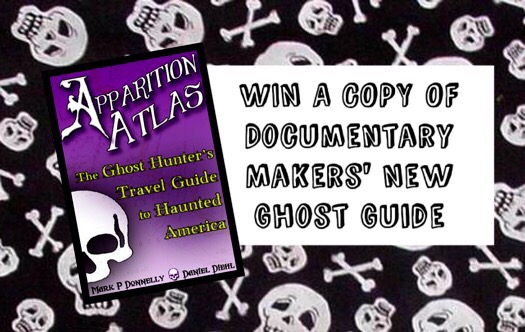
Win a Copy Apparition Atlas by Daniel Diehl & Mark P. Donnelly
TO WIN: FILL IN THE FORM AT THE BOTTOM OF THE PAGE. 6 WINNERS WILL BE CHOSEN, AT RANDOM, ON OCTOBER 1, 2015.
Have you ever had an encounter with a ghost? Would you like proof that the deceased continue to visit the world of the living? Do you have the courage to stand face-to-face with visitors from the afterlife? ‘Apparition Atlas: The Ghost Hunter’s Travel Guide to Haunted America’ provides seekers of truth with a definitive guide to more than 200 publicly accessible, verified haunted locations in all fifty states. Introductory chapters discuss the many different types of apparitions and explain everything the novice ghost hunter needs to know to search for things that go bump in the night.
5 winners will receive an eBook and 1 winner will receive a signed copy of Apparition Atlas
Sometimes the spirits of the dead manifest themselves by slamming doors or through blood chilling screams; other times they come as glowing orbs of ectoplasm that float through walls, and occasionally they appear in their human form – fully formed, semi-transparent and terrifyingly real. Let us take you on a journey to places where close encounters with the departed occur with frightening regularity.Guaranteed to make you doubt everything you believe about death being the end of existence.
 Written by investigative historians Daniel Diehl and Mark P. Donnelly, whose ghost-hunting has been featured on The History Channel, A&E Networks, The Biography Channel, and Discovery Network.
Written by investigative historians Daniel Diehl and Mark P. Donnelly, whose ghost-hunting has been featured on The History Channel, A&E Networks, The Biography Channel, and Discovery Network.
Enter to Win a FREE Copy of Apparition Atlas
Please Click Here for Giveaway Rules (WARNING: They’re boring.)
About the Authors
Daniel Diehl has been an author, writer and investigative historian for thirty-five years. For nearly twenty years Diehl has been involved in writing for publication and documentary television production. His canon of work includes twenty non-fiction books (which have been translated into ten foreign languages), one previous work of fiction and scripts for more than one hundred and seventy hours of documentary television primarily for A&E Network, The History Channel, History International, the Biography Channel and Discovery Network. In addition to his books and scripts Diehl has served as historical consultant on such films as The Color Purple (Amblin Entertainment, 1986), Darrow (PBS Television Theatre, 1991) and Baskin’s Run (Finnegan’s Wake Productions, 1994).
Mark P. Donnelly is an historian, author, screenwriter, duelist, bon vivant, and constant gentleman. He has authored, co-authored or ghost written over 20 titles in several countries and has scripted and/or produced nearly 200 hours of historical television programming. He can frequently be found traveling throughout the north-eastern US giving lectures and presentations at themed events as well as teaching historical swordsmanship and western martial arts. He currently resides in central Pennsylvania where he enjoys life with his wife and family.
